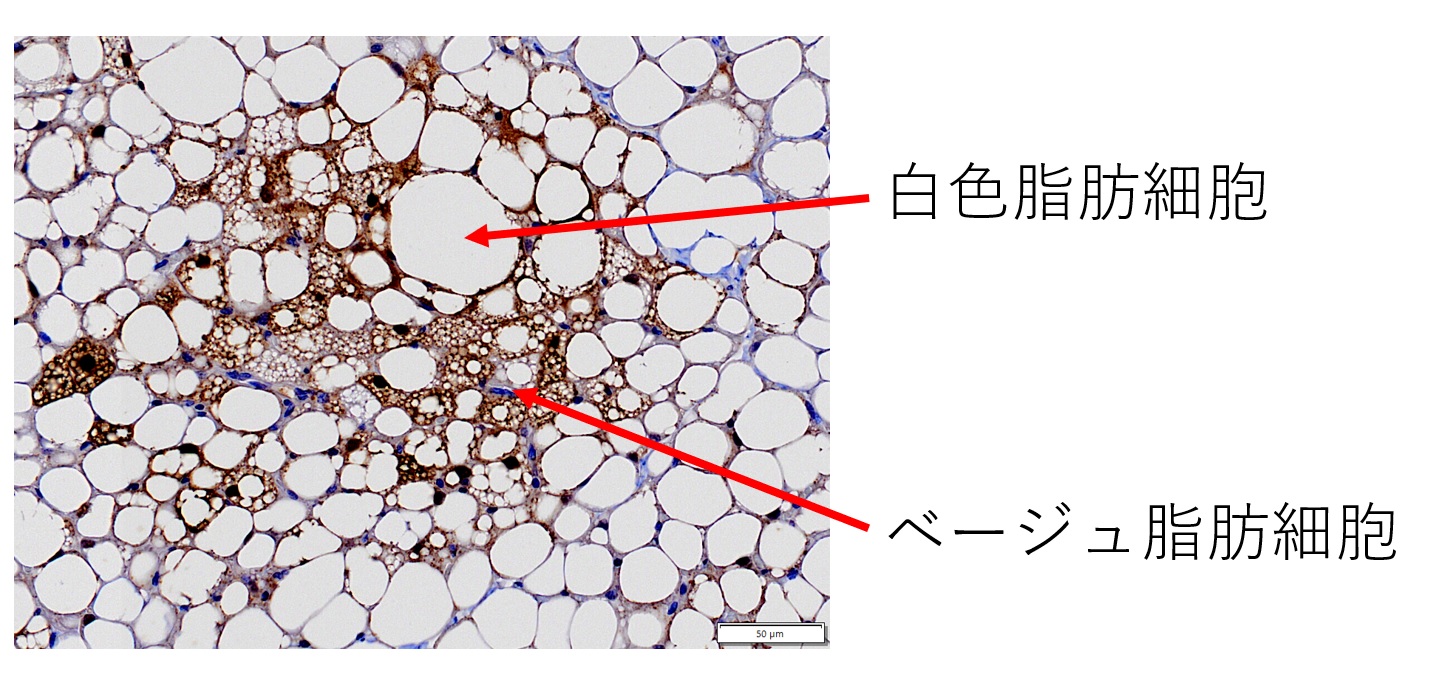医科学専攻
- Master's Courses
修士課程 - Doctoral Courses
博士課程
Molecular Physiology and Metabolism分子代謝生理学
STAFF
Professor
-
Sakai, JuroProfessor. 酒井 寿郎 教授

Other Faculty / Staff
-
Yoneshiro, Takeshi
Assoc. Prof. 米代 武司 准教授 -
Takahashi, Hiroki
Assistant Prof. 高橋 宙大 助教 -
Arai, Makoto
Assistant Prof. 荒井 誠 助教 -
Kobayashi, Eri
Assistant Prof. 小林 枝里 助教
CONTACT
TEL:+81-22-717-8117
E-MAIL:jmsakai*med.tohoku.ac.jp
(「*」を「@」に変換してください)
OUTLINE
Lifestyle-related diseases such as type 2 diabetes, dyslipidemia, hypertension, and atherosclerosis caused by visceral obesity are now major health issues in medical science. Attention is being paid to the mechanism by which the onset of lifestyle diseases is caused by the functional failure of adipocytes. Adipose tissue is an important tissue that controls systemic metabolism and dynamically remodels in response to environmental changes including nutritional status and living temperature. How does this information change the characteristics of adipose tissue for the adaptation of the individuals?
Epigenetics, from the Greek " epi, " means " on, " DNA. All of our tissues contain the same 30,000 genes; however, in a given tissue and at a given stage, owing to an " epigenetic code, " only a few of these genes are expressed, giving rise to the " phenotype. " Disruption of the balance of epigenetic networks may cause several major diseases. The Sakai laboratory is now focusing on solving the pathophysiological mechanisms in obesity and its comorbidities by studying the epigenetic network. Our current research focuses on studying the link between paternal exposure to cold environmental temperature prior to reproduction that results in offspring exhibiting greater energy consumption and heat generation. We are also focusing on the link between energy imbalance and incorrect "epigenetic programming " in the development of obesity because of inadequate maternal nutrition and/or metabolic disturbances.
メタボリックシンドローム、2型糖尿病、動脈硬化など多因子疾患の解明は21世紀の生物医学の大きな課題となっています。
ヒストンのメチル化などを解するエピジェネティックな遺伝子発現の制御(後天的遺伝子修飾)が細胞分裂を越えて保存され、一個体の間の細胞記憶システムを形成し、このことが生活習慣病の 発症に大きな役割を果たしていることが明らかにされつつあります。
エピゲノムとは、DNA塩基配列以外のDNAのメチル化とヒストン修飾で維持される遺伝情報です。
生活習慣はエピゲノムに記憶され、生活習慣病・糖脂質代謝異常発症の鍵となることが示唆されています。
それでは、環境因子がどのようにエピゲノム修飾へと変換されるのでしょうか?
環境変化に応じた翻訳後修飾はタンパク質が持つ多面的な機能から固有の機能を選別するスイッチです。
私たちはヒストン修飾酵素の翻訳後修飾解析と遺伝子上の局在解析、タンパク質複合体解析からこれらを明らかにしていきます。
そして、睡眠、エネルギー代謝、制御メカニズムをエピゲノミックス解析から明らかにし、画期的な生活習慣病の治療法に挑戦していきます。

集合写真
研究室の風景
寒冷曝露で皮下脂肪に集まる熱産生ベージュ細胞
ARTICLE
Yoneshiro, T., Matsushita, M., Fuse-Hamaoka, S., et al. Pre-fertilization-origin preservation of brown fat-mediated energy expenditure in humans. Nat Metab 7, 778-791, 2025.
URL:https://www.nature.com/articles/s42255-025-01249-2
Yang, C., Arai, M., Ariyanto, E.F., Zhang, J., Lubis, D.M., Ito, R., et al. Glucose-activated JMJD1A drives visceral adipogenesis via alpha-ketoglutarate-dependent chromatin remodeling. Cell Rep 44, 116060, 2025
URL:https://pubmed.ncbi.nlm.nih.gov/40720241/
Matsumura, Y., Wei, F.-Y., and Sakai, J. (2023). Epitranscriptomics in metabolic disease. Nat Metab 5, 370-384 2023
URL:https://www.nature.com/articles/s42255-023-00764-4
Takahashi H, et al. MYPT1-PP1β phosphatase negatively regulates both chromatin landscape and co-activator recruitment for beige adipogenesis. Nat Commun. 13: 5715, 2022
URL:https://www.ncbi.nlm.nih.gov/pmc/articles/PMC9523048/
Matsumura Y, et al. Spatiotemporal dynamics of SETD5-containing NCoR-HDAC3 complex determines enhancer activation for adipogenesis. Nat Commun. 12: 7045, 2021
URL:https://www.nature.com/articles/s41467-021-27321-5

 糖が「新しい脂肪細胞をつくるスイッチ」になる仕組みを解明―脂肪のつき方を決める鍵となる酵素を同定―
糖が「新しい脂肪細胞をつくるスイッチ」になる仕組みを解明―脂肪のつき方を決める鍵となる酵素を同定―
 受精前の気象環境が脂肪燃焼機能に影響することを発見-親から子へと伝搬する褐色脂肪の活性化-
受精前の気象環境が脂肪燃焼機能に影響することを発見-親から子へと伝搬する褐色脂肪の活性化-
 エピゲノム変化が脂肪のエネルギー消費を促進し肥満を抑制する -肥満や糖尿病の発症機序解明に期待-
エピゲノム変化が脂肪のエネルギー消費を促進し肥満を抑制する -肥満や糖尿病の発症機序解明に期待-
 RNA修飾と生活習慣病に関する総説論文を発表 - 新たな治療法や予防法の開発に期待 -
RNA修飾と生活習慣病に関する総説論文を発表 - 新たな治療法や予防法の開発に期待 -